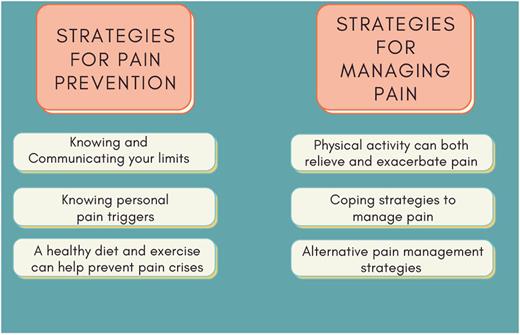Abstract
Background
Innovations in medicine over the last fifty years have extended the median lifespan of people living with sickle cell disease (SCD) from 14 years to as long as 61 years in cohorts from academic centers. There is a paucity of information on the experiences preventing and managing vaso-occlusive pain crises by older adults with SCD. Older adults with SCD have decades of experience navigating pain and other complications of SCD. They have a wealth of knowledge about how to care for themselves, which can be shared with a younger generation of those with SCD. The purpose of this study was to describe strategies used by older adults (≥50 years) to prevent and manage pain crises.
Methods
We enrolled 19 men and women at least 50 years old from a single comprehensive sickle cell center in the Southeastern United States. We conducted semi-structured qualitative interviews by phone or in person. A single interviewer asked open-ended questions about the participant's experiences living with SCD and strategies they feel helped them live a long life. Participants described strategies they have adopted to cope with and prevent pain crises. A commercial service transcribed audio-recordings of the interviews verbatim. We used conventional content analysis to code the transcripts.
Results
The mean age of participants was 58 years (range 50-71). Over half (53%) had HbSS genotype, 37% had HbSC, and 11% had HbSβ+-thalassemia. Almost half (45%) were hospitalized and 63% had an emergency room visit in the last year. Most participants (84%) were on short-acting and 37% were on long-acting opiates. The majority (58%) reported current use of hydroxyurea.
During the interview participants discussed strategies used to prevent and manage their pain crises. There were two major themes. (Figure 1)
Theme 1 was "Strategies for Pain Prevention", which centered on methods they adopted throughout their lives to help prevent pain crises. Participants described that when they were younger pain medicine was not readily available, causing them to focus on strategies to prevent pain crises. They often relied on their parents to set limits on their activity levels to avoid having a crisis. When they reached adulthood, they learned to advocate for themselves by communicating their limitations. Having a good support system to encourage them to rest also helped. Most participants emphasized the importance of moving at their own pace and slowing down when they needed to.
They discussed how knowing their triggers helped avoid a pain crisis or manage it better on their own. Sometimes simply sleeping once they felt a pain crisis coming on could help avert a crisis. Avoiding stressful situations, emotional triggers, temperature extremes, being underdressed, sitting long periods, and dehydration helped to prevent pain crises.
Most participants described how a healthy diet and exercise were key in the prevention of pain crises. Eating fruits and vegetables, avoiding sugary drinks, excessive alcohol, and processed foods helped reduce pain episodes. They described low impact exercises they engaged in such as walking, yard work, and cycling.
Theme 2 was "Strategies for Managing Pain” which included using pharmacological and non-pharmacological methods. One of the most important strategies participants mentioned was to rest as soon as a pain crisis started. For some, physical activity helped relieve pain, while for others, it was a trigger for a crisis. The strategies adopted also included hydration, heating pads, resting, distraction techniques, and avoiding stress as much as possible. Alternative pain management strategies that were reported included acupuncture, massage, and aquatic therapy. While pain medication was useful, many participants stated that they did not like being prescribed pain medicine without other therapies.
Conclusion
The growing population of older adults with SCD have a wealth of knowledge that can benefit younger adults with SCD to prevent and manage pain crises. Strategies they have learned through a lifetime of experience living with SCD have given them a unique insight into how to best cope with pain crises. In future research we will evaluate how best to share approaches developed by people with SCD for preventing and managing SCD complications.
Disclosures
Strouse:Takeda: Consultancy.
Author notes
Asterisk with author names denotes non-ASH members.


This feature is available to Subscribers Only
Sign In or Create an Account Close Modal